1.
Croydon
(Tramlink),
or back to: [intro] [menu]
London
has two light rail systems in addition to the Underground and
suburban rail services. These are the Docklands Light Railway
(DLR) and Croydon Tramlink. Both systems have connections to the
Underground and to suburban rail services. Croydon Tramlink is
fed by bus routes serving housing estates in and around New Addington,
an area which had limited access to public transport before the
system opened. Where possible, bus and tram stops are placed close
together, with step-free access between them.
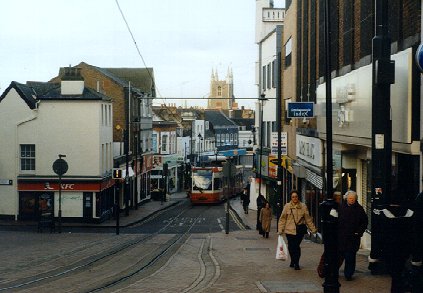
Photo:
(C) Light
Rail Atlas/Rob van der Bijl
Croydon, centre, February 14, 2002
 "Because Trams Beat Jams!"
"Because Trams Beat Jams!"
In
July 1998, John Prescott stated in a Government White paper that:
'In a major consultation exercise, people made clear that the
time for action is long overdue. People want more choice, more
alternatives to using their cars and more reliable journeys when
they do drive. They want a better public transport system that
doesn't let them down. They want better protection for the environment,
and they want less pollution because they are worried about their
health.'
Tramlink meets the criteria stated in the White Paper.
It provides a real alternative to the private car, reduces pollution,
improves journeys for thousands of people everyday and contributes
to the economic well being of the area it serves.
Less
is More
Tramlink's electrically powered trams are energy and space efficient.
In fact a 30 metre tram (the length of 6 cars) can carry up to
200 people, and that's nearly 3 times as many as a double decker
bus.
A double tram track has more capacity than a dual carriageway,
yet requires only one third of the space. Trams use far less fuel
per passenger than cars, taxis, and other road vehicles, and do
not emit any fumes.
Overhead
Power
Tramlink is much less intrusive than conventional railways as
it does not need wide sections of segregated track. Our trams
can also climb steeper gradients and handle tighter curves, thereby
fitting in around existing buildings and spaces. Long stretches
of our routes use converted railway tracks which are no longer
in use, minimising visual and noise impact.
Noise
Impact
One of the outstanding features of Tramlink is the quiet and smooth
running of the trams. Powered by electricity wires overhead, modern
trams generate none of the engine noise of cars, lorries or other
road vehicles. In fact Tramlink has been designed with noise reduction
in mind. In order to minimise noise, wheels are lubricated to
reduce squeaking and track is continuously welded and mainly set
in ballast. At our depot all practical steps have been taken in
accordance with the 1990 Environmental Pollution Act.
Air
Quality
Existing modes of transport are significant sources of air pollution.
Exhaust fumes are thought to cause harm to health particularly
to those already suffering from respiratory illnesses. Motor vehicle
gases also contribute to global warming - about half the current
warming effect is due to carbon dioxide (CO2). The Croydon Environment
Audit 1995 estimated that nearly 880,000 tonnes of CO2 are emitted
by vehicles in the Croydon area every year. Although the generation
of electricity needed to run trams has the potential to create
air pollution from the power station, this is subject to strict
government controls and trams do not emit fumes or pollutants.
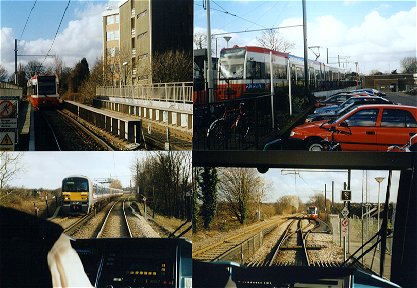
Photo: (C) Light
Rail Atlas/Rob van der Bijl
Croydon, TramTrain
interchange, Beckenham, February
14, 2002
Flora
& Fauna
In building the Tramlink system, we have kept to a minimum the
need to disrupt wildlife. Where trees absolutely had to be removed
then replacement planting forms part of the landscaping works.
When this landscaping is complete there will be more trees in
the area than there were prior to construction. Croydon Council
has responsibility for landscaping, for which it has set aside
a million pounds, and is undertaking a comprehensive programme
of replanting which ensures high standards are met.
Soil
& Architectural Surveys
Any soil brought into the Addington Hills area is similar to existing
soil to ensure that 'alien' material is not imported. The opportunity
is being taken to re-establish areas of heather which have been
smothered by recent tree growth. Wessex Archaeology carried out
an Archaeological Impact Study to identify and protect all known
or suspected remains along the routes - archaeological investigations
took place during construction in certain areas.
Badgers
Discussions were held with wildlife groups and the Joseph Firbank
Society on the most appropriate ways of protecting badgers living
along the route. Badger tunnels and badger proof fences will ensure
that badgers cross safely and with ease.
 Creating new open space
Creating new open space
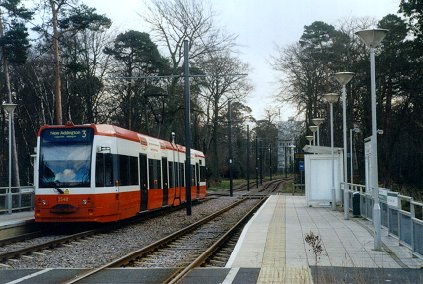
Photo:
(C) Light
Rail Atlas/Rob van der Bijl
Croydon, Coombe Lane, February 14, 2002
Croydon
Council has established 2 new open spaces to replace land used
by Tramlink:
Stroud Green Well in Shirley. This 5 acre site was once a playing
field but had become overgrown. It has now been cleared and opened
to the public.
Threehalfpenny Wood. 6 acres previously known as Addington Soakage
Field has been transformed and opened to the public.
 Network
Network
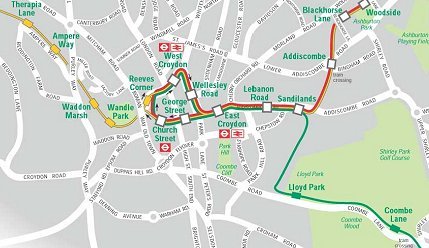
Three
lines cover the conurbation of Southern London:
 1 - to Wimbledon
in the west, and a branche tot the northeast
1 - to Wimbledon
in the west, and a branche tot the northeast
 2 - to Beckham
(northeast)
2 - to Beckham
(northeast)
 3- to housing
area New Addington (southeast)
3- to housing
area New Addington (southeast)
All lines use the single loop in the centre of Croydon.
 Data
Data
 Opened in
May 2000. Cost of construction: £200 million. Tramlink operates
in and around Croydon, south London. Line 1 runs between Wimbledon
in the south west, where it connects to London Underground, via
a loop in central Croydon, to Elmers End in the east, with connections
to suburban rail services. Line 2 links central Croydon with suburban
rail services in Beckenham. Line 3 serves New Addington in the
south east. Feeder buses provide further links in the area.
Opened in
May 2000. Cost of construction: £200 million. Tramlink operates
in and around Croydon, south London. Line 1 runs between Wimbledon
in the south west, where it connects to London Underground, via
a loop in central Croydon, to Elmers End in the east, with connections
to suburban rail services. Line 2 links central Croydon with suburban
rail services in Beckenham. Line 3 serves New Addington in the
south east. Feeder buses provide further links in the area.
 Operator:
Tramtrack Croydon / FirstGroup.
Operator:
Tramtrack Croydon / FirstGroup.
 Number of
stations: 38, all wheelchair accessible. Step-free access to low
platforms and the adjacent streets.
Number of
stations: 38, all wheelchair accessible. Step-free access to low
platforms and the adjacent streets.
 Length of
Route: 28 km, 3 lines.
Length of
Route: 28 km, 3 lines.
 Staff: 181
Staff: 181
 Fleet: 24
trams, all wheelchair accessible.
Fleet: 24
trams, all wheelchair accessible.
 ·
Power supply: 750V DC overhead line.
·
Power supply: 750V DC overhead line.
 Partly segregated,
with on-street running in Croydon. Many ungated level crossings
of roads and footpaths. No track or signal sharing with other
railways. Trams use their own platforms in Wimbledon and Elmers
End stations.
Partly segregated,
with on-street running in Croydon. Many ungated level crossings
of roads and footpaths. No track or signal sharing with other
railways. Trams use their own platforms in Wimbledon and Elmers
End stations.
 Passenger
kilometres 2000/01: 96 million.
Passenger
kilometres 2000/01: 96 million.
 Passenger
journeys 2000/01: 15 million.
Passenger
journeys 2000/01: 15 million.
 Passenger
receipts 2000/01: £12.2 million.
Passenger
receipts 2000/01: £12.2 million.
 Future expansion:
possible extensions to Crystal Palace via Penge or Anerley, and
to Sutton via Morden, subject to feasibility studies and funding.
Future expansion:
possible extensions to Crystal Palace via Penge or Anerley, and
to Sutton via Morden, subject to feasibility studies and funding.
2.
Docklands
(DLR),
or back to: [intro] [menu]
London
has two light rail systems in addition to the Underground and
suburban rail services. These are the Docklands Light Railway
(DLR) and Croydon Tramlink. Both systems have connections to the
Underground and to suburban rail services.
 "Will move into profit"
"Will move into profit"
Docklands
light railway (DLR) is of particular interest as it combined elements
of infrastructure funding from increasing land values and profits
from subsequent land sales through a quasi-public holding agency
(London Docklands Development Corporation/LDDC), which was also
temporarily responsible for building and operating the light railway.
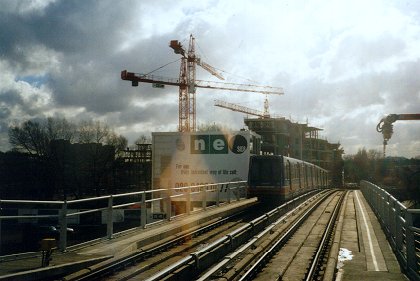
Photo: (C) Light
Rail Atlas/Rob van der Bijl
London, Greenwhich, February 14, 2002
After
planners had initially regarded improved bus services as sufficient
for the amount of additional uses envisioned for the Docklands,
it was soon realised that a fixed-track system would not only
provide much better service quality, but also be a powerful demonstration
to private developers that the government was taking the regeneration
program seriously, thus capable of kick-starting the process (Collins
1990, Schabas 1990). The initial 12-km segment linking Tower Gateway,
Stratford and Island Gardens was funded at equal parts by LT and
LDDC, contracted out in a turnkey arrangement and was built for
only A $ 26.8m per km (1998 values), the lowest figure for completely
grade-separated alignments (see.
While an early parliamentary vote assured half the capital cost
for the Docklands Light Railway (DLR) to be covered by central
government, and commitments of developers could be gained towards
upgrading and extensions in later stages (most notably a £67m
contribution by the now-bankrupt main investor on Canary Wharf,
Olympia and York), the railway soon ran into capacity limits as
well as technical difficulties with automated operation. Costly
replacement of control and signalling systems, which constrained
operations over a 3-year period, as well as additional engineering
tasks like extending platform lengths and inserting level-free
track crossings at route junctions stepped up capital costs which
now stand at more than A $ 110m per km, including two extensions
totalling 9.5 km. Poor reliability and the necessity to suspend
evening and weekend services for the upgrading work had gnawed
at DLR's public image and made its cost recovery ratio plummet
to a low of 15% when the railway was transferred from the responsibility
of London Transport (LT) to LDDC in early 1992.
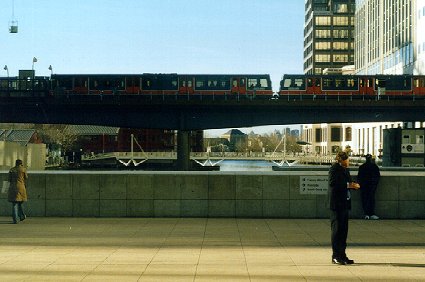
Photo:
(C) Light
Rail Atlas/Rob van der Bijl
London, Docklands, February 14, 2002
Since
that year, patronage has grown threefold following DLR's upgrading
and extensions and the ongoing intensification of urban activity
in the Docklands area. Cost recovery, too, has improved to over
80% in 1998 (Hope 1999), not least assisted by unconventional
means like hiring out under-used workshop facilities to private
clients. The extension to Beckton, opened in 1994, was made to
prove that it could, over time, be funded from land value increases
in this then largely obsolete corridor (Collins 1990) - a task
facilitated by the fact that LDDC was both the serviced area's
largest landowner and the light rail investor, which eliminated
the need for complicated taxing schemes or lengthy negotiations
with private landowners on funding contributions. Eventually,
DLR's service to Beckton started before redevelopment did, thus
representing a strong incentive to transit-oriented revitalisation.
A further extension of the network to Greenwich and Lewisham,
including an underground Thames crossing, has been contracted
to a private consortium in a 25-year concession to fund, design,
build and maintain, so DLR operates the route on a leaseback basis.
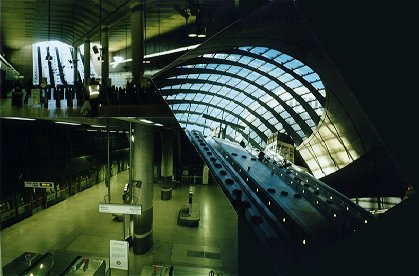
Photo:
(C) Light
Rail Atlas/Rob van der Bijl
London, Docklands, Jubilee Line, February 14, 2002
There
are reasonable expectations that DLR's operation might move into
profit once this crucial link will be in service for some time.
Simultaneously, the Jubilee Line underground extension to Canary
Wharf, as a result of an earlier government decision to improve
access to this largest urban redevelopment area in Europe, is
opened already.
While it had earlier been regarded as a potentially threatening
competition to DLR, after the tremendous increases in ridership
there is now widespread consensus among operators and policymakers
that it brings much-needed relief from DLR's overcongestion and
assist both systems to coordinate to mutual advantage.
 Data
Data
 Opened in
1987, at an initial cost of £77 million. Since the original
opening, three line extension projects have been carried out:
to Bank (1991, £294m), connecting to London Underground,
to Beckton (1994, £280m), to Lewisham (1999, £250m),
connecting to Connex Rail services. DLR now links Canary Wharf
with the City of London, east and south east London.
Opened in
1987, at an initial cost of £77 million. Since the original
opening, three line extension projects have been carried out:
to Bank (1991, £294m), connecting to London Underground,
to Beckton (1994, £280m), to Lewisham (1999, £250m),
connecting to Connex Rail services. DLR now links Canary Wharf
with the City of London, east and south east London.
 Operator:
Serco Docklands Ltd / CGL Rail.
Operator:
Serco Docklands Ltd / CGL Rail.
 Number of
stations: 34, all accessible to wheelchairs, generally by lifts.
Number of
stations: 34, all accessible to wheelchairs, generally by lifts.
 Length of
route: 27 km, much of it on viaducts.
Length of
route: 27 km, much of it on viaducts.
 Staff: 370
Staff: 370
 Fleet: 70
passenger cars, all wheelchair accessible.
Fleet: 70
passenger cars, all wheelchair accessible.
 Power supply
750V DC side rail.
Power supply
750V DC side rail.
 Fully segregated
elevated metro style system.
Fully segregated
elevated metro style system.
 Passenger
kilometres 2000/01: 200.1 million.
Passenger
kilometres 2000/01: 200.1 million.
 Passenger
journeys 2000/01: 38 million.
Passenger
journeys 2000/01: 38 million.
 Passenger
receipts 2000/01: £29 million.
Passenger
receipts 2000/01: £29 million.
 Future expansion:
a new line to serve London City Airport. Subject to granting of
powers, construction is due to start early in 2002, due to open
in 2004-5.
Future expansion:
a new line to serve London City Airport. Subject to granting of
powers, construction is due to start early in 2002, due to open
in 2004-5.
3.
Birmingham/Wolverhampton,
or back to: [intro] [menu]
 New Light Rail in the West Midlands
New Light Rail in the West Midlands
Promoted
by Centro and the West Midlands Passenger Transport Authority,
the £145 million Midland Metro opened in the summer of 1999,
it is the first street tramway to run in the West Midlands for
over fourty years. Funding for the project was gathered from various
sources.
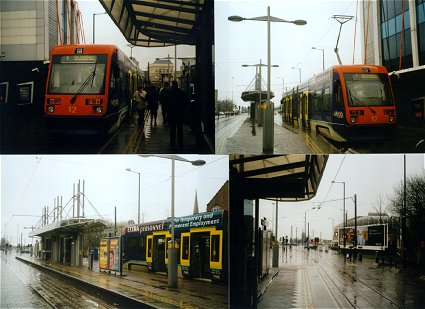
Photo:
(C) Light
Rail Atlas/Rob van der Bijl
West Midlands, Wolverhampton, March 14, 2002
The Government gave a £40 million grant and a £40
million approved loan towards the project. £31 million came
from a European grant, £17.1 million from the West Midlands
Passenger Transport Authority, £11.4 million from the private
consortium ALTRAM (who were chosen to design, construct, operate
and maintain the system). £4 million came from Birmingham,
Sandwell and Wolverhampton Councils in conjunction with the Black
Country Development Corporation, £1 million from Centro
and £0.3 million from utility services.
ALTRAM is the consortium running the show, having won a 23 year
concession to operate the system. The ALTRAM team has been responsible
for the construction, design and operation of Midland Metro Line
1. Travel West Midlands was awarded the management contract to
operate Line 1 and a separate division, Travel Midland Metro,
was specially formed to operate and maintain the new Light Rail
System. Travel Midland Metro Head Quarters based in Wednesbury
has been imaginatively named the METRO CENTRE (not to be confused
with the giant North East shopping mall!)
John Laing plc, constructors of Birmingham International Airport's
Eurohub terminal, were responsible for the construction of the
track, stops and buildings. Ansaldo Trasporti, the Italian-based
rail and signalling supplier, were responsible for delivering
the trams, signalling and communications equipment, overhead line
equipment and power suplly.
 Privatisation and PFI Deals in the
West Midlands
Privatisation and PFI Deals in the
West Midlands
Source:
Labour Research Department for the GMB (October 2001)
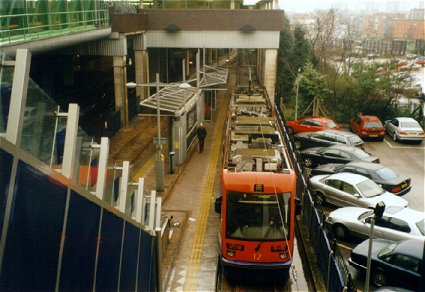
Photo:
(C) Light
Rail Atlas/Rob van der Bijl
West Midlands, Birmingham/centre, March 14, 2002
Introduction
of a report which looks at how far public services in the West
Midlands Area have been transferred to the private sector.
The
report finds that the private sector is now getting more than
£200 million a year from operating public services in the
area. This does not include the income from two major transport
schemes, the Midland Metro Line 1 and the motorway alternative
to the M6 between junctions 4 and 11.
It identifies a total of 119 separate contracts from 26 separate
public authorities, ranging from the housing repairs to urban
planning services to the provision of catering services.
By far the biggest is the £50 million per year repairs and
maintenance contract that Birmingham City Council gave Serviceteam
in April this year. Together with the £25 million contract
given to Accord at the same time, this means that repairs and
maintenance for
88,000 council properties are in the hands of these two contractors
for the next five years.
This is not Serviceteam's only contract with Birmingham City Council.
It also has a £5m grounds maintenance contract running for
10 years. Other companies with more than one contract in the West
Midlands include: Compass Group plc, which owns Chartwells and
Sutcliffe Catering (UK), has four contracts in the area; We Are
Cleaning (GB) has contracts with three authorities and Brophy
plc has two separate contracts with Wolverhampton Council. Onyx
has contracts with Birmingham City Council and Walsall Hospitals
NHS Trust, with the Birmingham City contract worth £25 million
a year.
Not all the authorities have provided details on the value of
the services carried out by the private sector (see below), but
using figures from those who have, it can be estimated that in
the West Midlands area these authorities pay some £140 million
a year to the private sector to deliver contracted-out services.
In addition, local bodies have signed 9 PFI deals in the West
Midlands area, and more are planned. In total these have a capital
value of £293 million. On average most larger, long-term
PFI schemes involve payments of between 20% and 25% of the capital
value per year. (The percentage is higher for shorter more capital
intensive schemes, like IT). This means that through the 9 PFI
schemes in the West Midlands area an estimated further £66
million is being paid to the private sector to deliver public
services.
PFI schemes have been signed by local councils, local health authorities
and central government departments: deals include the refurbishment
of 10 Birmingham schools; the provision of a new hospital radiology
department, and two waste to energy contracts.
Furthermore, there are 2 PFI deals in the West Midlands Area with
a capital value of £595 million in the transport sector.
These are the Midland Metro Line 1 and the new toll alternative
to the M6 between junctions 4 and 11. The precise value to the
contractors involved, is difficult to calculate as it depends
on usage but the companies involved can count on retums over a
long period, 20 years after construction for the Midland Metro
Line 1 and 50 years for the motorway.
 Network
Network
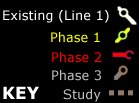
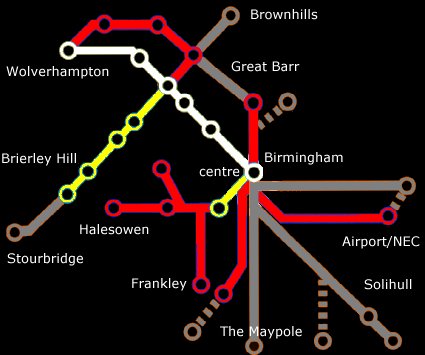
Phasing
of the Midland Metro network development (from the Highh Volume
Corridors Study of consultant Steer Davies Gleave (2001):
 Phase 1 -
Extensions to the excisting line (Birmingham-Wolverhampton). Two
branches: from Wednesbury to Brierly, and in Birningham from Snow
Hill (current terminus) to the city centre.
Phase 1 -
Extensions to the excisting line (Birmingham-Wolverhampton). Two
branches: from Wednesbury to Brierly, and in Birningham from Snow
Hill (current terminus) to the city centre.
 Phase 2 -
three new routes, from Great Barr through Birmingham city centre
to Bournbrook, from Airport/Nec, again throught Birmingham centre
to Oldbury, Halesowen and Frankley, and from Wolverhampton to
Walsall.
Phase 2 -
three new routes, from Great Barr through Birmingham city centre
to Bournbrook, from Airport/Nec, again throught Birmingham centre
to Oldbury, Halesowen and Frankley, and from Wolverhampton to
Walsall.
 Phase 3-
Many options possible. All programmed to open in 2012.
Phase 3-
Many options possible. All programmed to open in 2012.
 Data
Data
 Opened: 1999;
Cost of construction: £145 million. Line 1 of a proposed
three line system, with a mixture of on-street and segregated
running on new formations.
Opened: 1999;
Cost of construction: £145 million. Line 1 of a proposed
three line system, with a mixture of on-street and segregated
running on new formations.
 Operator:
Altram consortium.
Operator:
Altram consortium.
 Number of
stations: 23, wheelchair accessible. Step-free access to low platforms
and streets.
Number of
stations: 23, wheelchair accessible. Step-free access to low platforms
and streets.
 Length of
route: 20 km
Length of
route: 20 km
 Staff: 144
Staff: 144
 Fleet: 16
passenger cars, all wheelchair accessible.
Fleet: 16
passenger cars, all wheelchair accessible.
 Power supply:
750V DC overhead line.
Power supply:
750V DC overhead line.
 Passenger
kilometres 2000/01: 55.8 million
Passenger
kilometres 2000/01: 55.8 million
 Passenger
journeys 2000/01: 5.4 million
Passenger
journeys 2000/01: 5.4 million
 Passenger
receipts 2000/01: £3.1 million
Passenger
receipts 2000/01: £3.1 million
 Future expansion:
proposed extensions further into central Birmingham and to Merry
Hill.
Future expansion:
proposed extensions further into central Birmingham and to Merry
Hill.
4.
Manchester
(Metrolink) ,
or back to: [intro] [menu]
 The best Light Rail system in the world?
The best Light Rail system in the world?
by Pete
Black (Light Rail Planning Officer, GMPTE)
Metrolink
has become such a part of Greater Manchester that if you buy a
postcard, the chances are that it will have a tram on it. At peak
times trams are crowded with people who used to commute by car
and off-peak it is well used by everyone. Metrolink has brought
an unprecedented level of mobility to many groups and has even
created new markets for public transport. So how and why is Metrolink
successful, and what new developments are there?
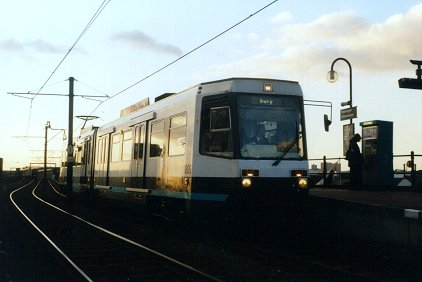
Photo: (C) Light
Rail Atlas/Rob van der Bijl
Manchester, G-MEX, February, 13, 2002
How
did it all start?
Metrolink opened in 1992 at a cost of around £152 million.
A design, build, operate and maintain (for fifteen years) contract
refurbished two run-down suburban rail lines and linked them by
a short section of track across Manchester City Centre with a
spur to Piccadilly, the main rail station. A fleet of 26 trams
operate a service every six minutes for most of the day between
Bury to the north of Manchester and Altrincham to the Southwest
over the 31km network.
Metrolink has now reached 13.9 million passengers a year and rising
after six years of operation. This compares to the forecast maximum
patronage of 12 million, and the 7.5 million annual trips made
on the two heavy rail lines before conversion to Metrolink. Detailed
monitoring studies have revealed that 65% of Metrolink passengers
have a car which they could have used instead of Metrolink and
that within the prime target area (within 2km of the line) between
14% and 50% of car trips to destinations served by Metrolink have
switched to Metrolink. These alone are stunning successes in a
conurbation with cheap and often free car parking for commuters
and little car restraint. Even better are the benefits that come
from full wheelchair accessibility to many other groups such as
parents with pushchairs or older people. Some completely new public
transport markets have appeared such as short trips within the
city centre, and journeys within the corridor rather than to the
major centres of Manchester, Bury and Altrincham.
Why
is it so successful?
It is not hard to see reasons for the success of Metrolink. The
system is simple and easily understood. Segregated suburban running
means quick journeys, and city centre track gives good access
to the main attractions and work places. The service is frequent
and reliable.
Most importantly the system is safe to travel on, and safe to
get to - stops and car parks have CCTV surveillance and "panic
buttons". The main problem seems to be the need for extra
capacity in the peak hours. Extra capacity would almost certainly
take more cars off the road.
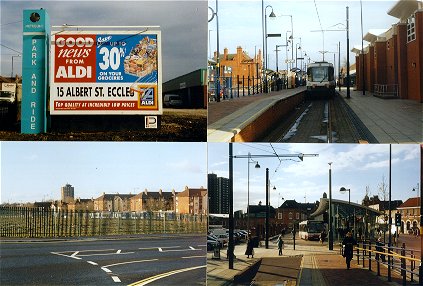
Photo:
(C) Light
Rail Atlas/Rob van der Bijl
Manchester, Eccles, February, 13, 2002
Where
are we up to?
Extensions were planned even before the first tram ran and if
they were all built would triple the network. Following the financial
and transport success of the first lines construction of the first
extension through Salford Quays to Eccles is now underway. A new
contract to design and build the ?160 million extension and to
operate the expanded network including the existing system was
put out to tender and was awarded to Altram. Altram is a consortium
of Laing (Civil Engineers), Ansaldo (Italian tram manufacturer),
Serco (operator), and 3i (venture capital company). The new line
will be very different from the existing system. The first section
threads through Salford Quays, a Docklands regeneration area.
Development has been patchy up to now due to poor access, but
Metrolink is likely to lead a building boom. The second section
is street running along Eccles New Road. This will serve a significant
residential population, a large park and ride site and the centre
of Eccles. The line is expected to open in Spring 2000.
Powers already exist for four further extensions to Oldham and
Rochdale (24 km), Manchester Airport (21 km), the Trafford Centre
(7 km) and East Didsbury (5 km). Greater Manchester Passenger
Transport Authority's top priority is now the scheme to take over
the Railtrack "Oldham Loop" line which will involve
new street running sections to serve the centres of Oldham and
Rochdale. This extension could carry eight million passengers
each year. The Airport Extension was approved by the Government
in 1997. As well as the huge potential for passenger and staff
journeys the line would serve Wythenshawe Hospital and a large
residential population in the south of the city. Powers also exist
to build Metrolink to the out-of-town Trafford Centre but the
Authority believes this line should be funded entirely by the
private sector. Compulsory purchase powers are currently being
renewed for this extension. Compulsory purchase powers are also
being renewed for an extension to East Didsbury. This line is
unlikely to be built as a complete extension but the potential
exists to extend the line to GMPTE is also awaiting the outcome
of a public inquiry held in June 1997 into proposals to extend
Metrolink 10km to Ashton-under-Lyne, serving a large residential
population, Ashton town centre and several major regeneration
areas including the Commonwealth Games site which will have a
new stadium.
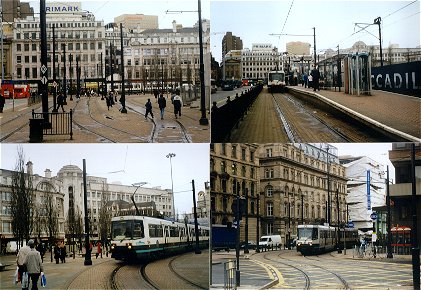
Photo:
(C) Light
Rail Atlas/Rob van der Bijl
Manchester, centre, February, 13, 2002
Conclusion
In just six years Metrolink has established itself as a very successful
transport system. It has increased mobility for many groups while
tempting people out of their cars. It has been able to do this
in a deregulated bus environment, with little or no traffic restraint
and without operating subsidy. It is an indispensable part of
any integrated transport strategy for Manchester.
The success of Metrolink may be partly to do with the size and
density of Greater Manchester, and the specific route. Light Rail
is an expensive option which can only currently be justified for
large cities. But it is a very impressive record, and a clear
indication that investment in good quality public transport works.
Come and see for yourselves!
 Network
Network
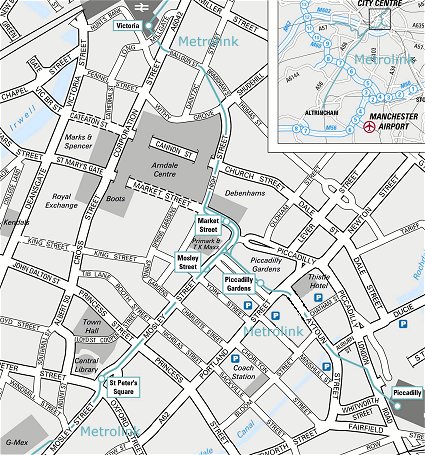
 Data
Data
 Opened: 1992
at an initial cost of construction of £140 million. A two
line system with both sections meeting on-street in central Manchester
in Piccadily Gardens. Extension to Eccles opened in March 2000,
£160 million.
Opened: 1992
at an initial cost of construction of £140 million. A two
line system with both sections meeting on-street in central Manchester
in Piccadily Gardens. Extension to Eccles opened in March 2000,
£160 million.
 Operator:
Altram.
Operator:
Altram.
 Number of
stations: 36. Standard height platforms as many suburban stations
are served by the system.
Number of
stations: 36. Standard height platforms as many suburban stations
are served by the system.
 Length of
route: 39.1 km
Length of
route: 39.1 km
 Staff: 303
Staff: 303
 Fleet: 32
passenger carriages, high floor design similar to trains, but
wheelchair accessible.
Fleet: 32
passenger carriages, high floor design similar to trains, but
wheelchair accessible.
 Power supply
750V DC overhead line.
Power supply
750V DC overhead line.
 Partly segregated.
Major use of former rail alignments, with street running in central
Manchester. Metrolink shares major stations with rail franchise
holders.
Partly segregated.
Major use of former rail alignments, with street running in central
Manchester. Metrolink shares major stations with rail franchise
holders.
 Passenger
kilometres 2000/01: 152.3 million
Passenger
kilometres 2000/01: 152.3 million
 Passenger
journeys 2000/01:17.2 million
Passenger
journeys 2000/01:17.2 million
 Passenger
receipts 2000/01: £18 million
Passenger
receipts 2000/01: £18 million
 Future expansion:
three extensions approved using a mixture of street running, former
railway alignments and some new alignments. One line will serve
Manchester Airport.
Future expansion:
three extensions approved using a mixture of street running, former
railway alignments and some new alignments. One line will serve
Manchester Airport.
5.
Nottingham
(NET),
or back to: [intro] [menu]
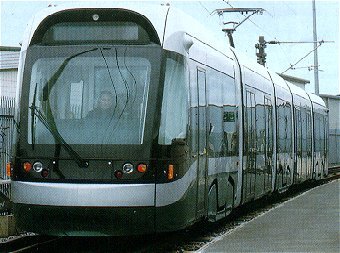
The first tram is unveiled at Bombardier's works in Derby on 13
August by Transport Minister John Spellar.
Photo courtesy: LRTA
 Nottingham
needed an integrated transport system
Nottingham
needed an integrated transport system
The
new tramway of Nottingham (UK) - Nottingham Express Transit line
1 - has been launched March 8th (2004) by Alistair Darling, the
Secretary of State for Transport. It took sixteen years of planning
and more than three years of construction to make this Grenoble
inspired tramway a reality. NET is a state-of-the-art tram system,
which is successful already. It runs from Hucknall, through Bulwell
and Hyson Green and into the city centre, terminating at Nottingham
railway station. There is also a spur line to Phoenix Park (just
off the M1 at junction 26).
Some
history... Back in 1988 Nottingham City Council and Nottinghamshire
County Council came together with Nottingham Development Enterprise
, representing local businesses interest, to consider the city's
future transport needs. It was clear that if Nottingham's fabric
and economy were to be regenerated and the Nottingham of the future
was to be a city that remained a great place to live, work and
visit then our transport infrastructure had to be renewed.
The overriding principle of these considerations was that Nottingham
needed an integrated transport system and that high quality, reliable
public transport had to form the backbone of that system. Nottingham
needed a public transport system that could move large numbers
of people without contributing the problems we needed to solve;
road congestion and local pollution. A number of options were
considered before a light rail vehicle, a tram, was decided upon
as Nottingham's solution. Powered by electricity, well-suited
to integration with the city's traffic management systems, clearly
of a high quality and economically feasible to build and to run
Nottingham's tram would form the ideal backbone to the public
transport system of the Nottingham of the future.
During 1994 working through the GNRT company, the two Council's
presented to Parliament their plans for the first line of a tram
system running from Hucknall, in the former coalfields to the
north of Nottingham, right through to the heart of the cityand
with a spur line to Cinderhill and attract motorists onto public
transport with ample park and ride facilities all along its route.
Lengthy deliberations in committees of the House of Commons and
House of Lords and the submission of extensive evidence covering
viability, public acceptability and environmental impact ended
with the granting, subject to a number of Undertakings on the
part of the two Councils, of permission to build Nottingham's
tram in the GNLRT Act 1994.
Tram systems are not cheap to build - but they are worth it. All
utility services must be moved from under the tram route before
tracks can be laid and overhead power lines installed. New bridges
must be built and new road layouts are needed. You need a fleet
of trams and depot in which to house and maintain them. All in
all a £200 million investment.
The two Council's invited tenders to build their tram system and
selected Arrow Light-Rail from a strong field as their chosen
concession company to design, build and operate Nottingham's tram.
Arrow Light-Rail comprises civil engineering firm Carillion ,
rail vehicle builder Bombardier (formerly ADtranz), experienced
integrated public transport operator Transdev and, importantly,
Nottingham City Transport the largest existing public transport
provider in the city.
Arrow's funding to build the tram is secured via a Private Finance
Initiative for which Government approved credit in December 1998.
Once this PFI funding was confirmed detailed negotiations were
embarked upon, in May 2000 contracts were signed and in June 2000
work to build a public transport system fit for the Nottingham
of the future began.
The NET Project Team, working for both Councils and based in Nottingham
City Council's Lawrence House offices, now acts as client for
the project ensuring that what Nottingham gets from Arrow is the
best system possible and the impact of construction on the vibrant
life of the city is minimised. The team is also managing the consideration
of future route options aiming to start work on more lines by
the time line one is complete. (2002)
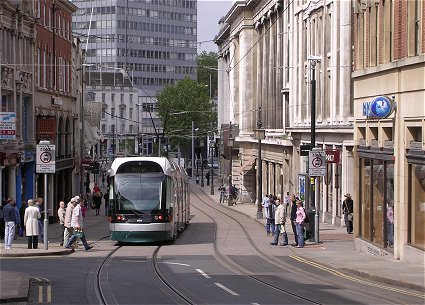
Photo:
(C) Light
Rail Atlas/Rob van der Bijl
Nottingham, city centre, May 27, 2004
 Design,
build, fund, operate and maintain
Design,
build, fund, operate and maintain
Arrow
Light Rail Ltd is a special purpose company formed to design,
build, fund, operate and maintain Line One of Nottingham Express
Transit (NET), a modern light rail tram system for Nottingham.
Arrow is owned by six partners, each bringing their own particular
skill and expertise to the organisation:
The Promoters of the scheme, jointly Nottingham City Council and
Nottinghamshire County Council, awarded the concession to Arrow
for a period of 30.5 years, under what is the largest local authority
Private Finance deal ever completed.
Arrow have let a 3.5 years fixed price turnkey contract to a consortium
comprising Adtranz and Carillion Construction for the design and
construction of the tram system. Adtranz are providing the trams,
power, signalling and communications systems, and Carillion the
civil engineering, track and tramstops.
Arrow has also let a contract to the Nottingham Tram Consortium
(NTC), comprising Transdev and Nottingham City Transport, who
will operate and maintain the system for 27 years.
 Network
Network
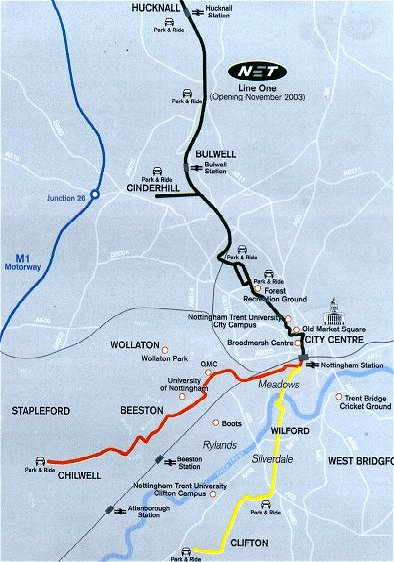
Line
1 runs from Hucknall, north of the city, into the centre of Nottingham
and its railway station. A park-and-ride site close to the M1
will be connected with Nottingham via a spur at Cinderhill.
A consultant team led by Turner & Townsend and officers of
the councils have developed proposals for expansion of the system
(mid 2002). They recommended routes for line 2 (Clifton via Wilford)
and line 3 (Beeston and Chilwell via Queens Medical Centre).



Photo:
(C) Light
Rail Atlas/Rob van der Bijl
Remained tracks of Nottingham's 'Victorian' tramway (closed 1936);
at bus depot (former tramway depot)
Nottingham, September 13, 2002
 Data
Data
 Opening:
March 2004. Cost of construction: £180 million (PFI).
Opening:
March 2004. Cost of construction: £180 million (PFI).
 Operator:
Arrow.
Operator:
Arrow.
 Number of
stations: 23 (including 5 P&R sites). Low platforms.
Number of
stations: 23 (including 5 P&R sites). Low platforms.
 Length of
route: 14 km
Length of
route: 14 km
 Staff: ...
Staff: ...
 Fleet: 15
passenger carriages (Bombardier), 100% low floor, 33 m long.
Fleet: 15
passenger carriages (Bombardier), 100% low floor, 33 m long.
 Power supply
750V DC overhead line.
Power supply
750V DC overhead line.
 Partly segregated.
Major use of former rail alignments (no track sharing), with street
running in central Nottingham.
Partly segregated.
Major use of former rail alignments (no track sharing), with street
running in central Nottingham.
 Future expansion:
two extensions planned (Line 2 and 3).
Future expansion:
two extensions planned (Line 2 and 3).
6.
Newcastle,
or back to: [intro] [menu]
 The Tyne and Wear Metro
The Tyne and Wear Metro
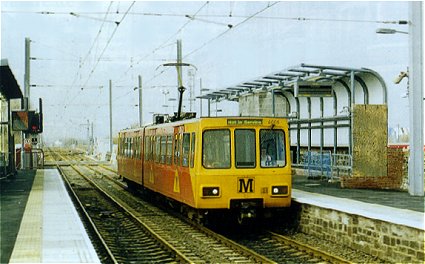
Track
sharing at East Boldon
On the 'main line' from Pelaw to Sunderland
Photo courtesy: LRTA
Newcastle
(300,000 inhabitants) is the centre of Tyne and-Wear, an urban
region (> 1,000,000 inhabitants) which includes other towns
like South Shields and Sunderland.
The Tyne and Wear network is a metro-like light rail system, using
newly built track and coverted main lines. The
river Tyne is crossed on a new bridge. There are also short tunnels
between Tynemouth and North Shields and between Chillingham Road
and Byker. Some grade crossings excist along the branch to the
Airport and one at Howdon on the route to Tynemouth. The new Sunderland
Line shares tracks with main line services.
The
system is operated by Nexus: the Tyne and Wear Passenger Transport
Executive, which also administers funds on behalf of the Tyne
and Wear Passenger Transport Authority. Patronage has been declined
due to bus deregulation during the eighties. Recently patronage
is improved. However, the use during the first months of its operation
of the Sunderland extension seems to be disappointing.
 Extension Sunderland
Extension Sunderland
Source:
LRTA (Iain D.O. Frew, 11 April 2002)
The
extension of the Tyne and Wear metro from Pelaw over Railtrack's
metals to Sunderland and thence over the relaid line to South
Hylton duly opened on Easter Day 31 March 2002. Park Lane station,
under Sunderland's bus station was not sufficiently complete and
will not open until 28 April, but everything else was ready. At
many of the stations the fitting out with metro furnishings was
not quite complete and many lack the laminated panels for the
walls of shelters, but this did not prevent the stations opening
for the new service. Nexus must be commended for how completely
they have resigned the entire system to include mention of Sunderland
and South Hylton on direction boards etc.
The
new service operates approximately every ten minutes - there are
slight variations due to the times of Railtrack workings. Services
comprise two articulated metrocars and this represents a considerable
increase in capacity over the former service. Arriva still run
a half hourly fast service from Central Station to Sunderland
and thence to Hartlepool or Teesside. The bi-hourly Transpennine
service from Liverpool to Sunderland that was to be cut back to
Newcastle continues to run though loads are light. The Metro service
replaces Arriva's half hourly locals.
The
volume of traffic originating at Sunderland is already much higher
than that generated by the former service. The eastern of the
two old island platforms has been widened and is used by all trains.
The northern end is used by Arriva and the southern end by Nexus.
A new entrance with a lift has been built at the northern end
which means that the substantial pram traffic attracted by the
Metro is at the wrong end of the station for the lift. Being totally
covered over the station is inevitably something of a dark hole
and a great deal more is needed to make it in any way attractive.
Fellgate, the first new stop east from Pelaw, is an immediate
success with steady traffic all day long. St Peter's in contrast
is extremely quiet so far - perhaps BR's decision years ago to
close adjacent Monwearmouth was justifiable after all! On the
reopened section of the Durham branch, University is building
up useful traffic and South Hylton is surprisingly busy. A nearby
school is producing substantial traffic. Pallion is quite busy
at peak hours but is quiet so far off peak.
The
South Hylton services are already overcrowded significantly at
busy times - not just the rush hour - and the question of three
car trains is already being mentioned. The platforms at all of
the new stations can be lengthened to take three cars easily,
as can all the stations on the pre-existing parts of the system.
The extension is off to a great start and there is so much potential
for further growth when new car parks become fully used, and communities
rediscover a convenient frequent service on their doorsteps
 The future of public transport in Tyne
and Wear starts here
The future of public transport in Tyne
and Wear starts here
Source:
NEXUS (25/07/02)
THE
Tyne and Wear Passenger Transport Authority has ratified a visionary
plan for the future of public transport in Tyne and Wear. Called
“Towards 2016”, the plan is the culmination of extensive
consultation on the future of public transport in Tyne and Wear
by public transport operators Nexus. The
opinions of local authorities, operators, passengers and the public
have been taken into account when compiling the document. And
there is widespread support for the plans which will bring 50
per cent of Tyne and Wear residents within reach of high quality
public transport.
Some
routes will be served by street-running trams which operate on
Metro tracks and some routes may be served by advanced bus systems.
Technical, financial and operational experts are now examining
the proposals in detail with a view to implementing the schemes
contained within the document.
Equally
welcomed are plans to make public transport easier to use, and
to provide flexible services that operate at times and to places
that are determined by passengers. An
extended commuter rail network will provide access to jobs for
people who live in Tyne and Wear and in neighbouring areas.
Mike
Parker, Director General of Nexus, said: “This report
heralds a new era in public transport provision. As congestion
grows the quality and capacity provided by public transport needs
to undergo a step change. The
next 15 years will see major projects such as Orpheus rally over
the mantle of the Metro, a major transformation of the speed and
reliability of our main bus services and new technologies in ticketing
and information which will reduce the need for cars for many journeys.”
Danny
Marshall, Chairman of the Tyne and Wear Passenger Transport Authority,
said: “I am delighted that this major plan has the support
of our five local authorities. We
all recognise that the ‘do nothing’ scenario is not
an option. “I will be working with my colleagues in the District
Councils in Tyne and Wear to ensure we have a coherent countywide
approach to transport issues such as parking and traffic management
to promote public transport as a more attractive option.”
 Network
Network
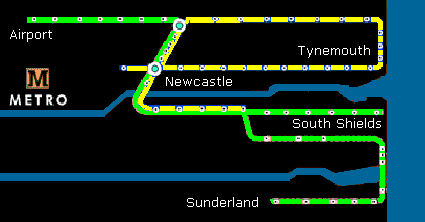
 Yellow line: Newcastle/centre-Tynemouth-Newcastle/centre-Pelaw.
Yellow line: Newcastle/centre-Tynemouth-Newcastle/centre-Pelaw.
 Green line:
Airport-Newcastle/centre-South Shields, -Sunderland.
Green line:
Airport-Newcastle/centre-South Shields, -Sunderland.
 Data
Data
 Opened: between 1980 and 1984, the first of the new metro style
systems outside London. Cost of construction: £284 million
(outturn prices). Mostly new railway construction under central
Newcastle and over the Tyne, with some use of former rail alignments.
An extension to Newcastle Airport opened in 1991, and to Sunderland
in early 2002 (partly track sharing).
Opened: between 1980 and 1984, the first of the new metro style
systems outside London. Cost of construction: £284 million
(outturn prices). Mostly new railway construction under central
Newcastle and over the Tyne, with some use of former rail alignments.
An extension to Newcastle Airport opened in 1991, and to Sunderland
in early 2002 (partly track sharing).
 Operator:
Nexus, the Tyne & Wear PTE.
Operator:
Nexus, the Tyne & Wear PTE.
 Number of
stations: 58
Number of
stations: 58
 Length of
route: 77 km
Length of
route: 77 km
 Staff: 606
Staff: 606
 Fleet: 90
passenger cars, all wheelchair accessible.
Fleet: 90
passenger cars, all wheelchair accessible.
 Power supply
1.5KV DC overhead line.
Power supply
1.5KV DC overhead line.
 Segregated
metro style system with some stations underground, and some grade
crossings.
Segregated
metro style system with some stations underground, and some grade
crossings.
 Passenger
kilometres 2000/01: 229.2 million
Passenger
kilometres 2000/01: 229.2 million
 Passenger
journeys 2000/01: 33 million
Passenger
journeys 2000/01: 33 million
 Passenger
receipts 2000/01: £24 million
Passenger
receipts 2000/01: £24 million
 Future expansion:
“Towards 2016” (street-running trams, which operate
on Metro tracks, and quality bus corridors).
Future expansion:
“Towards 2016” (street-running trams, which operate
on Metro tracks, and quality bus corridors).
7.
Sheffield
(Supertram),
or back to: [intro] [menu]
 Is it really super?
Is it really super?
The
agglomeration of South Yorkshire centred around Sheffield became
the second urban region in Britain to reintroduce street-running
light rail in 1994. Unlike Manchester's Metrolink which connected
two existing suburban rail lines, Sheffield's 29 km Supertram
system was developed from scratch, largely without using existing
rail infrastructure and involving a high share of on-street alignments,
making up over half of
the network.
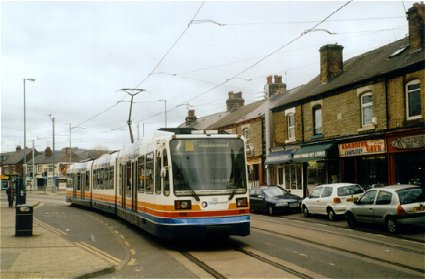
Photo: (C) Light
Rail Atlas/Rob van der Bijl
Sheffield, Middlewood, March 14, 2002
Also,
construction and initial operation of the system was carried out
by a subsidiary of the publicly-owned regional agency South Yorkshire
assenger Transport Executive (SYPTE) and only privatised (as planned)
in 1998, four years after opening.
Funding of the Supertram derived largely from a central government
grant and regional loans (in equal parts), while local businesses,
most prominently a large shopping centre at one of the five branch
termini, also contributed a minor amount.
More than in most new light rail cities, Sheffield's Supertram
faced an uphill battle among policymakers, the general public,
the media and not least the competitive public transport environment.
While planning authorities had, after years of studies and debates,
gained approval and funding for Supertram as the preferred option
to alleviate the traffic stranglehold and CBD decline Sheffield
was experiencing, the high level of
disruption to businesses and traffic along the routes during construction
appears to have dimmed public enthusiasm about the project even
before inauguration.
Other than Manchester's Metrolink which could bank on existing
patronage from the heavy rail lines it took over, Sheffield's
Supertram had no influence on the kind and level of services bus
providers would continue to offer in its corridors and thus started
virtually from zero. A number of teething problems had to be overcome,
such as the regulation of traffic along the on-street alignments
which had initially caused trams to be caught up in congestion,
or the procedures for ticketing and cooperation with other carriers
(after stationary ticket machines had become prone to vandalism,
Supertram resorted to the introduction of on-board conductors
which seems to have resulted in a not insignificant ridership
boost). While all indications are that the CBD has gained economically
with retail sales and building occupancy rates up, revitalisation
of other areas along Supertram's corridors appears to be slow
and not obviously higher than in parts of Sheffield not served
by the system. Above all, the development of ridership has been
below expectations for the first few years, though latest figures
(post-1996) look more optimistic.
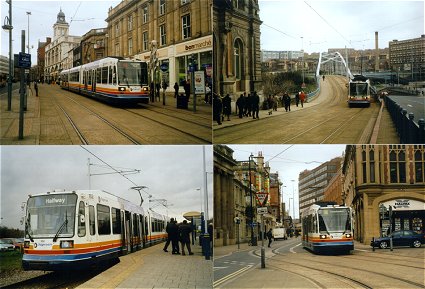
Photo:
(C) Light
Rail Atlas/Rob van der Bijl
Sheffield, centre & Halfway, March 14, 2002
Not
surprisingly, the unfavourable first years of Supertram put an
enormous financial strain on the operator, then still controlled
by SYPTE. Unbacked running costs and non-trading credits had caused
financial liabilities to SYPTE amounting to £115m in early
1998. The agency lost a court case against national government
who had wrongly been perceived as contractually tied to bridging
this gap. The debt burden resulted in a rather symbolic sale value
of £1.5m when Supertram's operations were privatised in
that year; the context was the likelihood of council tax increases
which would have worked further against the public image of Supertram
and possibly of light rail schemes in Britain in general (Harding
1998).
However,
since 1998 much has been improved! Supertram is used very well
during the last few years. This Light rail is reallly super,
as a local newspaper stated. Parts of the infrastructure is or
will be improved. Extensions has been planned.
 Network
Network
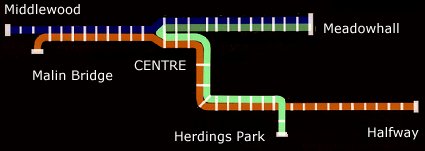
 Middlewood-centre-Meadowhall
Middlewood-centre-Meadowhall
 Malin Bridge-centre-Halway
Malin Bridge-centre-Halway
An extra service operates between 9 am and 6 pm from Meadhall
to Herdings Park via centre. This third line shuttles between
3 stops in the centre. Trams from Meadowhall turns at Cathedral
for direction Herdings Park (and vice versa).
 Data
Data
 Opened: 1994/95.
Cost of construction: £240 million. On-street running tramway
with some segregation from other traffic.
Opened: 1994/95.
Cost of construction: £240 million. On-street running tramway
with some segregation from other traffic.
 Operator:
Stagecoach Holdings (from 1997). Owned by South Yorkshire Passenger
Transport Executive.
Operator:
Stagecoach Holdings (from 1997). Owned by South Yorkshire Passenger
Transport Executive.
 Number of
tram stops: 47, step-free access, wheelchair accessible.
Number of
tram stops: 47, step-free access, wheelchair accessible.
 Length of
route: 29 km
Length of
route: 29 km
 Staff: 250
Staff: 250
 Fleet: 25
passenger cars of low floor design, all wheelchair accessible.
Fleet: 25
passenger cars of low floor design, all wheelchair accessible.
 Power supply
750V DC overhead line.
Power supply
750V DC overhead line.
 Passenger
kilometres 2000/01: 38 million
Passenger
kilometres 2000/01: 38 million
 Passenger
journeys 2000/01: 11 million
Passenger
journeys 2000/01: 11 million
 Passenger
receipts 2000/01: £7 million
Passenger
receipts 2000/01: £7 million
 Future expansion
plans: route extensions are being considered.
Future expansion
plans: route extensions are being considered.
8.
Future
projects,
or back to: [intro] [menu]
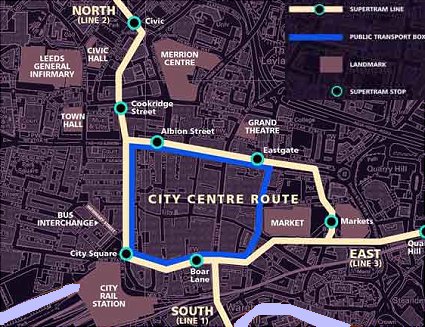
Leeds
Centre Loop of the new 3-line system
Approval
was granted in March 2001 for the £487 million Leeds Supertram
and the £190 million South Hampshire Rapid Transit, both
of which are currently at the tendering stage and are due for
completion in 2006. Three extensions to Manchester Metrolink are
also at the tendering stage. New systems are also planned for
Bristol (£194m) and Merseyside (£215m). Transport
for London is considering four rapid transit schemes in the capital,
using either guided buses or trams. A number of other schemes
are under consideration or are being developed by local authorities.
9.
Blackpool
and more,
or back to: [intro] [menu]
 Balloons and doubledecks
Balloons and doubledecks
Blackpool is the only 'Victorian' tramway which survived the
destruction of UK's trams in the pre- and post-war period of the
last century. Still doubledeck trams run along the boulevard.
Some of them are called 'balloons'.
In the near future this old tramway will possibly be converted
to a real light rail system.
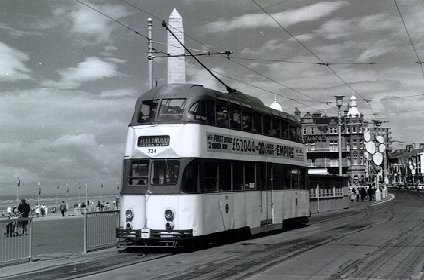
Photo: (C) Light
Rail Atlas/Rob van der Bijl
Ballooncar at boulevard
Blackpool, summer 1978
 More...
More...
All
other tramways in the UK are heritage, museum, or tourist systems
(such as Beamish, Crich and Seaton).